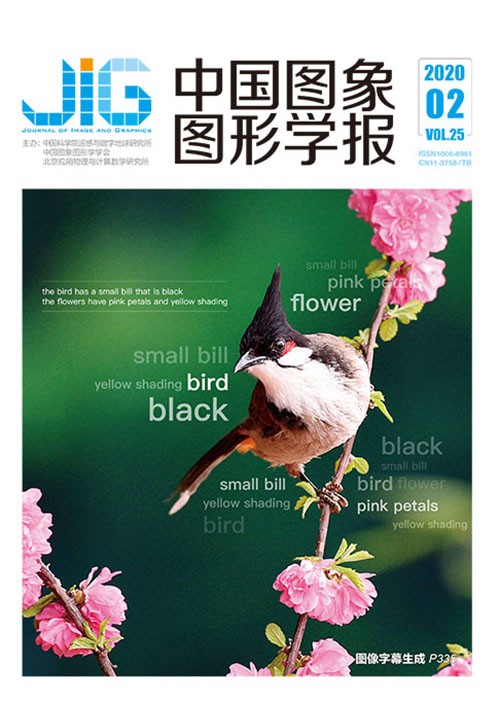
融合各向异性扩散信息的图像分割
摘 要
目的 图像因各种因素的影响存在一定程度的噪声,而噪声会在图像分割时影响待分割目标的边缘识别,导致分割结果难以达到理想状态。针对以上问题,在距离规则化水平集(DRLSE)演化模型的基础上,提出一种将各向异性扩散散度场信息融合到DRLSE模型中的新模型。方法 将水平集函数初始化为分段常数表达式,设定演化方程中的参数和水平集函数演化过程中的迭代时间步长Δt。随后将常值权系数α替换为融合各项异性扩散散度场信息的变权系数α(I),对水平集函数的演化方程进行迭代演化,直至收敛到目标边缘。输出最终演化轮廓。结果 对选自Weizmann数据库的图像和经过人为改造的的图像进行图像分割实验,采用迭代时间和评价分割结果相似性的J系数(Jaccard相似性系数)和D系数(Dice相似性系数)等定量指标进行评价。对无噪声图像和噪声图像分割时,本文模型的J系数和D系数均比DRLSE模型的值大,表明本文模型的分割结果与真值图像的相似性较高。在分割时间方面,仅在分割背景简单边缘清晰的无噪声图像时,本文模型较DRLSE模型略长;在分割边缘清晰、背景灰度不均匀和边缘模糊、背景灰度不均匀的无噪声图像以及人为添加噪声的各种情况下,本文模型分割时间均明显短于DRLSE模型。其中,对边缘模糊、背景灰度不均匀的无噪声图像,本文模型分割时间为3.718 s,较DRLSE模型短9.523 s;对存在噪声、待分割目标存在凹区域且边缘模糊背景灰度不均匀图像,本文模型分割时间为4.235 s,较DRLSE模型短35.165 s。结论 实验结果表明,融合了各向异性扩散信息的DRLSE模型在图像分割尤其是噪声图像分割方面,具有明显的有效性、高效性和鲁棒性。
关键词
Image segmentation based on anisotropic diffusion information
Song Kaile1,2, Ma Songhua2(1.School of Mechanical Engineering, Shandong University, Jinan 250061, China;2.Key Laboratory of High Efficiency and Clean Mechanical Manufacture, Shandong University, Ministry of Education, P. R. China, Jinan 250061, China) Abstract
Objective Image segmentation is based on the grayscale information of the image, and the homogenous regions with different properties of the image are divided using different methods without overlapping each other. When image segmentation is performed to obtain the region of interest, the image will inevitably have a certain degree of noise due to various factors, the noise will cause the image edge to be weakened, the false edge will be generated during segmentation, the segmentation curve will fall into the local minimum, and the evolution will stop. The situation, in turn, affects the accuracy of the edge recognition of the target to be segmented during image segmentation, and the segmentation result encounters difficulty in achieving the desired effect. The level set method based on active set is widely used in image segmentation, but it is still affected by noise. Thus, a new method is proposed to solve the noise problem. Method Since given that the anisotropic diffusion model is applied to image segmentation, including denoising and maintaining the edge of the target to be segmented, a new model is proposed to fuse the anisotropic diffusion divergence field information into the DRLSE model to improve the efficiency and accuracy of the existing segmentation algorithm of the noise image based on the distance regularization level set (DRLSE) evolution model.The model can overcome the problems of the distance regularized level set model, such as slow convergence speed, easy to fall into the false boundary and leak from the weak edge. The improved model can accelerate the initial contour evolution to the edge of the target to be segmented when segmenting the noise image. The main improvement is to change the constant coefficient α of the control area term in the DRLSE evolution model to the variable weight coefficient α(I) on the basis of the anisotropic diffusion divergence field information. Given that the improved variable weight coefficient is based on the anisotropic diffusion information, the improved nonedge force is considerably smoothed down, the vector force at the edge is strengthened, and the edge interfered by noise is strengthened. The improved model can accelerate the initial contour evolution to the edge of the target to be segmented when segmenting the noise image. Result Image segmentation experiments are performed on several images selected from the Weizmann database and artificially modified images. Segmentation time, D coefficient, and J coefficient are compared (the closer the D and J coefficients to the 1 segmentation result and true value image similarity, the higher the ratio, and the greater the similarity between the segmentation efficiency and result). The noise-free image is segmented. If the image background is simple and the edge is clear, then the D-factor and J-factor of the model segmentation result are 0.996 4 and 0.992 4, respectively. The D-factor and J-factor of the DRLSE model segmentation result are 0.995 6 and 0.990 6, respectively. The model segmentation time is 3.809 s. Compared with the 3.809 s of the DRLSE model, the D-factor and J-factor of the model segmentation result are 0.994 6 and 0.993 1, respectively, and the D-factor and J-factor of the DRLSE model are 0.991 1 and 0.981 8, respectively. The model segmentation time of 4.294 s is shorter than the DRLSE model's 4.966 s. For the edge part, the fuzzy background gray image is uneven. The D and J coefficients of the model segmentation result are 0.997 1 and 0.989 3, respectively. The D and J coefficients of the DRLSE model segmentation result are 0.970 4 and 0.931 5, respectively. The model segmentation time of 3.718 s is shorter than the DRLSE model's 13.241 s. The noise image is segmented. If the background of the image is simple, then the edge is only an artificially added noise. The D and J coefficients of the model segmentation result are 0.997 6 and 0.995 0, respectively, and the D and J coefficients of the DRLSE model segmentation result are 0.997 2 and 0.994 2, respectively. The time of 4.182 s is shorter than the DRLSE model's 11.274 s. For the image with noise and uneven edge gray, the D and J coefficients of the model segmentation are 0.990 3 and 0.980 2, respectively. The D and J coefficients of the DRLSE model segmentation result are 0.980 5 and 0.960 3, respectively. The model segmentation time of 4.294 s is shorter than the DRLSE model's 4.966 s. For the image where the noise is to be segmented, a concave region is observed, and the edge blurred background gray is uneven. The D and J coefficients of the model segmentation result are 0.985 7 and 0.970 9, respectively. The D and J coefficients of the DRLSE model are 0.885 3 and 0.747 3, respectively. The model segmentation time of 4.235 s is shorter than the DRLSE model's 39.400 s. Results of the segmentation experiments show that the improved model is considerably better in terms of segmentation accuracy and runtime than the original model for noisy and noise-free images. Conclusion In this paper, we introduce the DRLSE evolution model based on the anisotropic diffusion divergence field model. The improved model can accelerate the curve evolution to the target boundary given gray unevenness in the background. The image can overcome the noise and edge weakening caused by the noise figure in evolution and several shortcomings of the DRLSE evolution model during evolution. Experimental results show the effectiveness, efficiency, and robustness of the fusion anisotropic diffusion information DRLSE model in image segmentation, especially noise image segmentation.
Keywords
|



 中国图象图形学报 │ 京ICP备05080539号-4 │ 本系统由
中国图象图形学报 │ 京ICP备05080539号-4 │ 本系统由